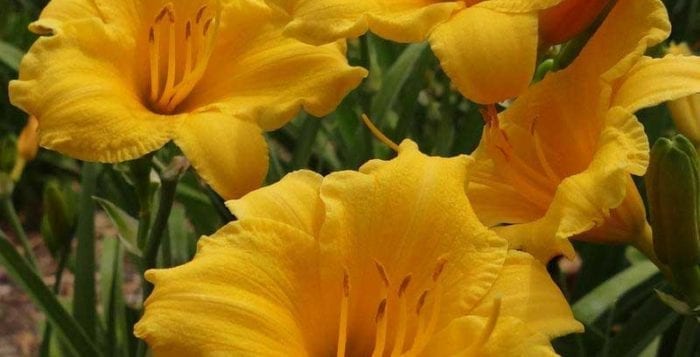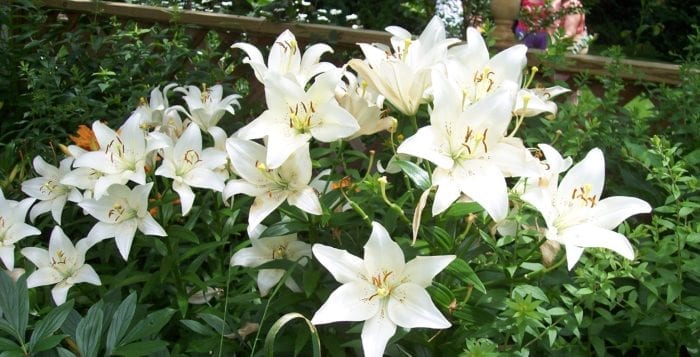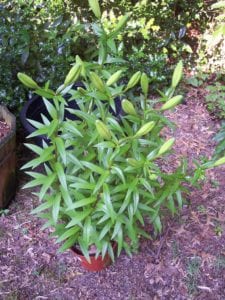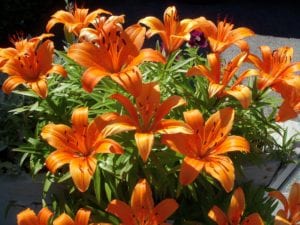By Ellen Barcel
This is the final article in a three-part series.
In the past two weeks, we’ve taken a look at plants with the word “lily” in their name that aren’t true lilies and then true lilies. Now, what about daylilies?
The daylily is in the genus Hemerocallis. The flowers of some daylilies are edible and are used in Asian cooking. Hemerocallis are perennials and are grown for their gorgeous flowers, which resemble true lilies. Since, for the most part, the flower opens at sunrise and only lasts until sunset, to be replaced by another the next day, they are commonly called daylilies. In fact, the term Hemerocallis translates as “beauty for a day” from the Greek.
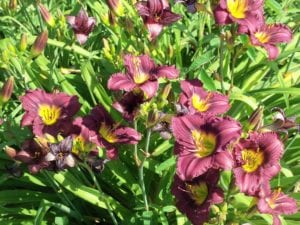
Daylilies come in a wide variety of colors. There are bi-colors (like ‘Moussaka’ with its white and maroon flowers) and ruffled flowers (like ‘Bestseller’ with its lavender and yellow-green, frilled petals). ‘French Lingerie’ has lavender-pink petals edged in gold.
The American Hemerocallis Society was formed for the perpetuation and study of daylilies. According to the society, Hemerocallis are extremely popular because of their wide variety of shapes, sizes and colors, their drought tolerance and pest and disease resistance. There are varieties that bloom from late spring until autumn and are suited to a wide range of climates.
They are natives of Asia and, as with Easter lilies, were brought to the west around the 1930s. Since then hybridizers have worked to improve them, resulting in the large variety of colors, petal shapes and sizes. Hardiness varies depending on variety with some being extremely hardy and others quite tender. Always check the tag that comes with your plant.
There are literally thousands of daylily cultivars. I’ve read over 80,000 but can’t confirm this number. Daylilies, as their name implies, produce flowers that just last a day but will continue producing flowers for a number of weeks. Since there are so many cultivars, it would be impossible in this column to go into detail about even a few of them, but several come to mind since they are so popular.
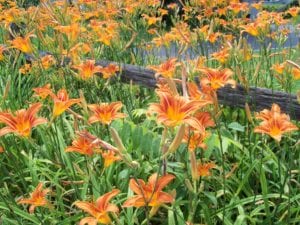
• Tiger lily (Hemerocallis fulvas) one of several lilies known collectively as tiger lilies. It is native to North America. Tiger lilies can be found growing along the roadside, hence the nickname “Ditch Lily,” as well as in cultivated gardens. They do well in moist soil, which explains why they grow well in ditches where water tends to collect. They are hardy from zones 3 through 9. Like Easter lilies, keep tiger lilies away from cats since it can cause a variety of symptoms including kidney failure.
• ‘Stella d’Oro’ is a compact rebloomer, comes in shades of yellow-gold and forms dense clumps, so dense that it can be used as a ground cover. They bloom practically all summer and into the fall.
• H. ‘Purple d’Oro’ is a dwarf reblooming daylily that looks great planted in clusters as ‘Stella d’Oro.’ It blooms in late spring to late summer and does well in sun and part shade. It comes in shades of dark purple and yellow.
Remember, the easiest way to tell lilies from daylilies is to look at the leaves. True lilies have leaves and flowers on the same stems and the flowers last for many days. Daylilies have flowers on a separate stem and last just a single day. Daylilies, unlike true lilies, have long, slender, fibrous roots and no true bulb. Since daylilies last just for a day, they are usually not used in floral arrangements.
For further information on daylilies, go to The American Hemerocallis Society at www.daylilies.org or lidaylily.org.
Ellen Barcel is a freelance writer and master gardener. To reach Cornell Cooperative Extension and its Master Gardener program, call 631-727-7850.

